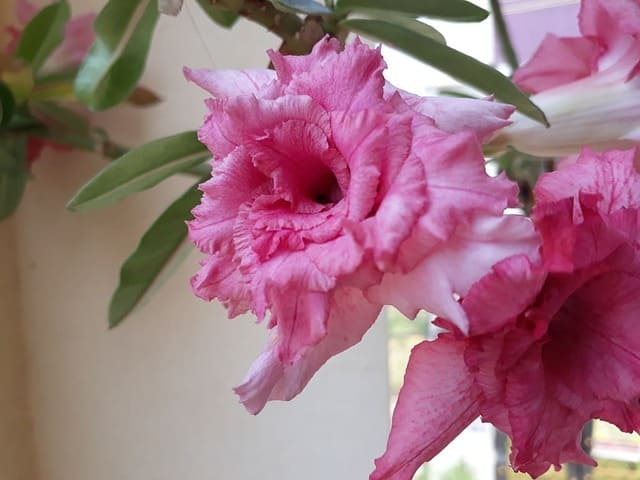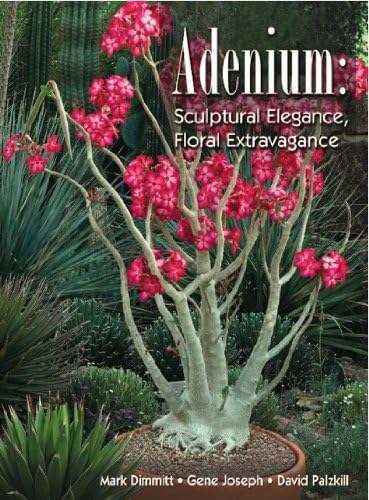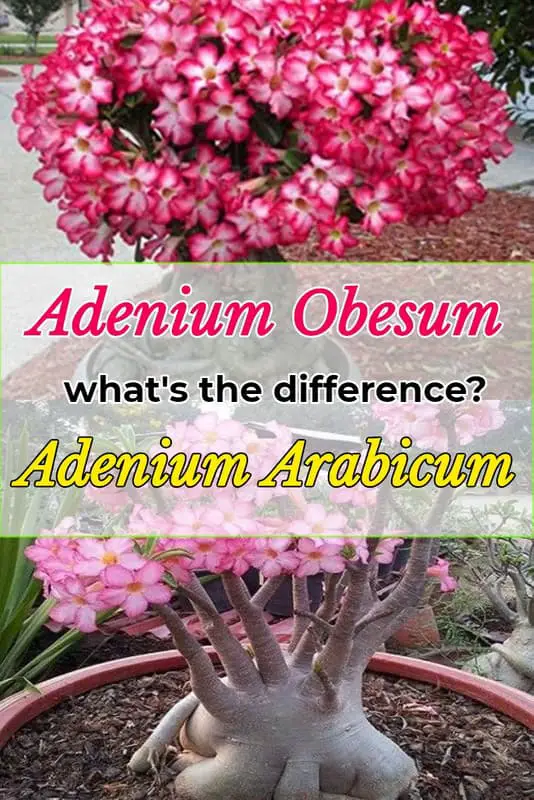Adenium Obesum and Adenium Arabicum are two of the most well-known species in the desert rose family. To tell their differences, we can look at the caudex, the leaves, and the flowers. It’s not at all too difficult. Let’s explore these two beauties right now.
Here are some of the differences:
Caudex
/obeum-arabicum-caudex.jpg)
As you can see right here, the Arabicum caudex is much bigger or fatter than Obesum caudex. If it is a pure Arabicum without any hybrids, its caudex can grow up to, well if we may put it frankly, the size of.. a refrigerator.
Obesum caudex is smaller in comparison. It doesn’t look that gigantic. And the caudex gets slimmer on the way up to the branches. The overall look of the Obesum caudex and its branches are quite balanced compared to the Arabicum.
And now, moving on, let's compare the leaves next:
Leaves
/obesum-arabicum-leaves.jpg)
Arabicum doesn’t usually produce that many leaves and most of them are quite clustered up on the top branches. Their leaves, however, are wider and shorter than Obesum leaves.
On both sides of the leaves, you may find very fine silky hair that can attract insects or spores as well. Though with some improved hybrid breeds, hybridizers have been able to remove the silky hairs on Arabicum leaves.
Obesum leaves are longer but narrower. They look like a water droplet—the shape you get when you put your index finger against your thumb. The surface of Obesum leaves doesn’t have silky hair. It’s quite waxy and more round near the tip of the leaf.
The flowers of these two varieties are also a bit different:
Flowers
/obesum-arabicum-flowers.jpg)
Arabicum flowers are a bit paler than Obesum. The shade is darker around the edges of the petals. At the throat of the flower tube, you will see five distinctive red marks running out about a quarter of an inch (a half centimeter) or so in the middle of the petals.
Obseum flowers have crimson red color when they are beginning to bloom. The redness fades away over time, leaving us with a nice pink color. The inside tube is yellow with some silky hair near the top of the tube.
Arabicum has pink flowers and white flowers. Hybrid Obesum, thanks to cross-pollination, has many more colors like white, purple, red, and yellow (but not true blue there are no natural all blue adenium as of now).
Arabicum and Obesum are known to be quite difficult to cross with each other.
And now at this point, can you guess which of the two has bigger seeds? Yes!
Seeds
/arabicum-obesum-seeds.jpg)
As you can probably guess by now, the seeds of Arabicum are bigger and fatter. Seeds of Obesum are usually about an inch or even shorter. They are also slimmer than the Arabicum seeds.
Arabicum x Obesum: Is It A Good Match?
When cross-pollinating Arabicum with Obesum, growers have not had very good success rates. It seems that it's difficult to get flowers & seed pods from this combination. They don't seem to blend well each other that much.
Dr. Mark Dimmitt, an adenium breeder, managed to get one successful breed out of hundreds of failed attempts.
For more information, you can check out the 'How to hand-pollinate adenium flowers' post here:

Before going to the comparison table, let us quote a few words of an adenium master:
The Master's Words On Adenium Comparison
Arabicum flowers are much smaller than Obesum and only pink. Arabicum body is way chubbier and from it is not growing a trunk but multiple branches up from that bottom swelling [caudex]. Arabicum variety is not in hybridizing (like Obesum flowers), but selected breading - line breading - to create types that are: semi-dwarf, dwarf, black or green or brown skin, branches that grow straight up or horizontal, heavy bloomers ...
–Garden S
Comparison Table: Adenium Arabicum vs Adenium Obesum
| Feature | Arabicum | Obesum |
|---|---|---|
| Caudex | Big, fatter | Smaller, thinner |
| Leaves | Shorter, wider with hairs on the surface | Longer, slimmer with waxy surface & no hairs |
| Flowers | Smaller pale pink | Bigger pink, red, yellow, white, purple |
| Seeds | Longer, fatter | Thinner, short |
| Trunk | Multiple big branches | One main trunk with branches |
If you like to explore more about adenium varieties, check out this fantastic book by Dr. Mark Dimmitt, an adenium lover for over 20 years:
| Get Best Picture Book for Adenium Lovers |
|---|
 |
| 400+ wonderful photos of adeniums (including rare ones) |
| Details of species from African safari trips |
| Tips on growing & propagating different varieties |
>> Link YouTube: Preview of the book below (at 0:24)
Rosa do Deserto é ADENIUM, com 11 espécies = 2ª ParteA video about the differences:
>> Link YouTube:
Adenium Obesum VS Arabicum - Desert Rose ComparisonSo Those Are the Differences
You see, it's not too difficult to differentiate Arabicum & Obesum desert roses. For us, we remember the Arabicum as the Big Guy.
We don't have a nickname for the Obesum yet, but we're thinking about the Popular Guy, maybe?! Hopefully the post has given you a better idea of how to identify these two species when you get one for yourself.
If you want a deeper dive into these two gorgeous beauties, here are:
For an endless exploration into the Adenium family, check out The Adenium Species List:
>> Link Blog post: Adenium Species List
It has been fun spotting all these adenium differences with you folks! We are glad that you join & See you here again next time.
Responses to Readers' Questions
I have a white Arabicum. I just read on here that arabicum only come in pink. So why do I have a white one? It also has the hairs on the back of the leaves.

--> Hello, thanks for your question. It is very interesting. Let me search around or ask the master himself Garden S. Btw, are you sure it's an Arabicum? Will get back to you. See you again next time.
Hello again. From what I've asked, yes there are white Adenium Arabicum flowers. It is interesting! And I just knew about this. Have added a note to the post, thank you very much for sharing. Hope this clarifies & Happy Holidays!
Why my Arabicum haven't flower yet?
--> Hi, thanks for your question. To begin with, may I ask how old is your Arabicum? If started from seed, it may bloom a year and a year a half from then usually.
Please also check the soil. Sometimes if there's still too much nutrients in the soil, the plant may decide to continue to build its branches and leaves and thus delay flowering. In another case, if there's not sufficient nutrients in the soil, it may also slow down the flowering process.
Can you also check how is the sunlight available? In bright warm environment, the desert rose can flower very easily. Sometimes multiple rounds a year as I've noticed. You may also look out for pests, fungi or insects. Other times it might also be the specific plant health or the variety.
If you're interested, I have a post here on why desert roses are not blooming and some solutions. I'll drop a link here if you wanted a look "Desert Roses Not Blooming: Easy Solutions": https://zenyrgarden.com/why-are-my-desert-roses-not-blooming/
I hope this helps & See you again next time!
Share or pin this post!



